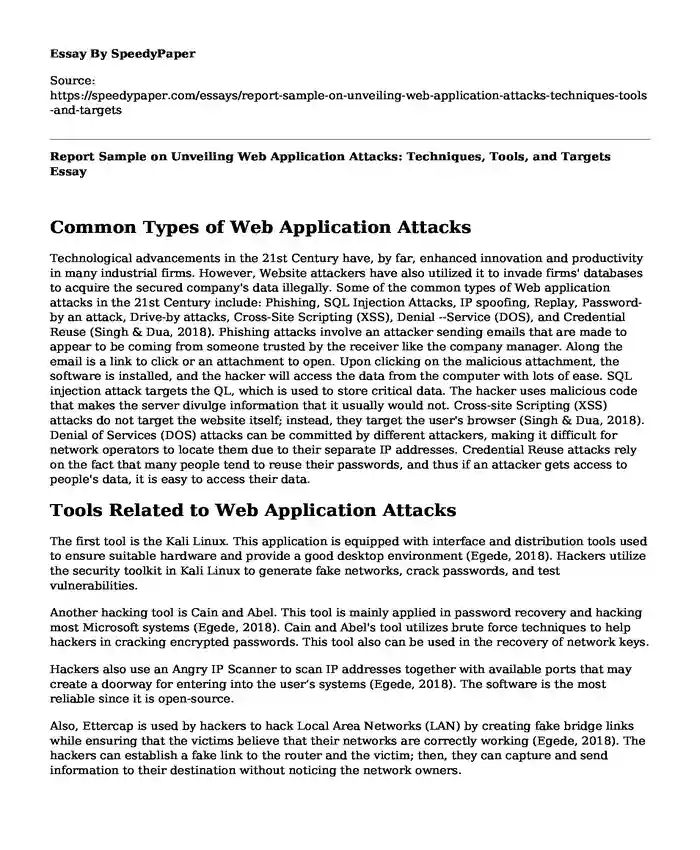
| Type of paper: | Essay |
| Categories: | Computer science |
| Pages: | 3 |
| Wordcount: | 606 words |
Common Types of Web Application Attacks
Technological advancements in the 21st Century have, by far, enhanced innovation and productivity in many industrial firms. However, Website attackers have also utilized it to invade firms' databases to acquire the secured company's data illegally. Some of the common types of Web application attacks in the 21st Century include: Phishing, SQL Injection Attacks, IP spoofing, Replay, Password-by an attack, Drive-by attacks, Cross-Site Scripting (XSS), Denial --Service (DOS), and Credential Reuse (Singh & Dua, 2018). Phishing attacks involve an attacker sending emails that are made to appear to be coming from someone trusted by the receiver like the company manager. Along the email is a link to click or an attachment to open. Upon clicking on the malicious attachment, the software is installed, and the hacker will access the data from the computer with lots of ease. SQL injection attack targets the QL, which is used to store critical data. The hacker uses malicious code that makes the server divulge information that it usually would not. Cross-site Scripting (XSS) attacks do not target the website itself; instead, they target the user's browser (Singh & Dua, 2018). Denial of Services (DOS) attacks can be committed by different attackers, making it difficult for network operators to locate them due to their separate IP addresses. Credential Reuse attacks rely on the fact that many people tend to reuse their passwords, and thus if an attacker gets access to people's data, it is easy to access their data.
Tools Related to Web Application Attacks
The first tool is the Kali Linux. This application is equipped with interface and distribution tools used to ensure suitable hardware and provide a good desktop environment (Egede, 2018). Hackers utilize the security toolkit in Kali Linux to generate fake networks, crack passwords, and test vulnerabilities.
Another hacking tool is Cain and Abel. This tool is mainly applied in password recovery and hacking most Microsoft systems (Egede, 2018). Cain and Abel's tool utilizes brute force techniques to help hackers in cracking encrypted passwords. This tool also can be used in the recovery of network keys.
Hackers also use an Angry IP Scanner to scan IP addresses together with available ports that may create a doorway for entering into the user’s systems (Egede, 2018). The software is the most reliable since it is open-source.
Also, Ettercap is used by hackers to hack Local Area Networks (LAN) by creating fake bridge links while ensuring that the victims believe that their networks are correctly working (Egede, 2018). The hackers can establish a fake link to the router and the victim; then, they can capture and send information to their destination without noticing the network owners.
Additionally, hackers utilize Burp Suite software in hacking since it is recognized as the best web app hacking software (Egede, 2018). The tool identifies website vulnerability points where hackers can attack with minimal resistance.
Lastly, hackers utilized the Metasploit tool. This software allows hackers to hack professionally since it helps identify security vulnerabilities in a website (Egede, 2018). The Metasploit delivers reports on hackers through vulnerability scanners, where hackers can identify the weak point to hack and jeopardize the whole system.
Assets Targeted by Web Attackers
The website attacker’s target assets are but are not limited to: confidential information of a company such as Social security numbers, personal data of the workers, the manufacturing process information of a specific product, and the website itself.
References
Egede, I. (2018, May 21). Hacking Tools: Web Application Hacking Tools. https://resources.infosecinstitute.com/hacking-tools-web-application-hacking-tools/.
Singh, H., & Dua, M. (2018). Website Attacks: Challenges and Preventive Methodologies. 2018 International Conference on Inventive Research in Computing Applications (ICIRCA). https://doi.org/10.1109/icirca.2018.8597259
Cite this page
Report Sample on Unveiling Web Application Attacks: Techniques, Tools, and Targets. (2023, Dec 29). Retrieved from https://speedypaper.com/essays/report-sample-on-unveiling-web-application-attacks-techniques-tools-and-targets
Request Removal
If you are the original author of this essay and no longer wish to have it published on the SpeedyPaper website, please click below to request its removal:
- Essay Example on Solutions to Cyberbullying
- Essay Sample in Cybersecurity: Yahoo Security Breach
- Essay Sample on Developing of the Quick App Marketing App
- Essay Sample on impacts of the e-government on corruption across Asian countries
- Interpretability in Machine Learning: A Requirement for Trustworthiness - Essay Sample
- Microwaves: Speedy Tool or Disaster on the Loose? - Essay Sample
- Free Essay Sample on Sustainability in Information Agencies
Popular categories




